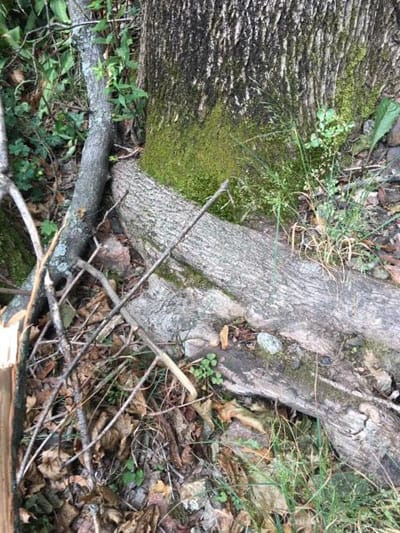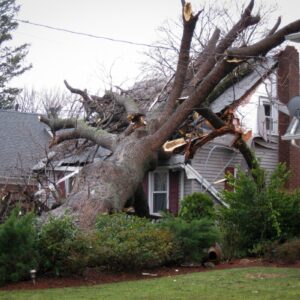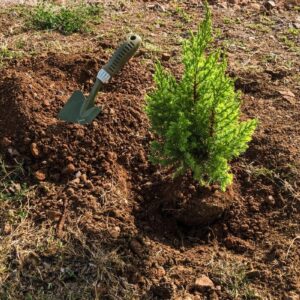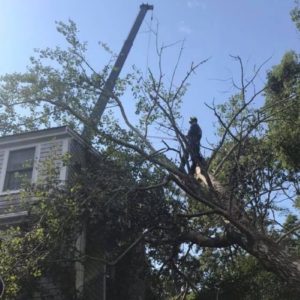There are many reasons why a tree may not look healthy. Insect pests, bacterial and fungal diseases, lack of water or nutrients, winter or storm damage, nearby construction, and improper pruning are some common reasons that many people are familiar with. But there’s one cause you may not know about – girdling roots.
These roots (sometimes called circling roots) coil around the trunk of a tree and “strangle” it to death by limiting nutrient and water transport from the roots to the tree canopy.
In this article, we look into girdling roots and how they affect trees in the MetroWest area of Massachusetts. Learn what these roots are, how they form, why they’re dangerous, and what you can do to prevent or correct them to save your trees. These dangerous roots can endanger the life of your tree; the faster you identify them, the better your chance of saving the tree.
Key Takeaways
- Root girdling could be slowly killing your landscape’s most valuable assets and posing a danger to your property and family without you even knowing it.
- Learn to spot the telltale signs of root girdling in your MetroWest property, from mysteriously stunted growth to trees that seem ready to topple at any moment.
- Common landscaping practices, like creating “mulch volcanoes” or planting trees in tight spaces, could be setting your trees up for a girdling disaster.
- Find out how professional arborists use cutting-edge techniques like air spading to safely diagnose and treat root girdling, potentially saving your trees and protecting your property.
- It’s important to address root girdling quickly, not just for tree health but also to avoid potential liability from falling trees during our notorious New England storms.
What is root girdling?
Root girdling is when roots wrap around a tree, strangle its growth, and cut off the flow of water and nutrients from the soil into the tree’s crown. The circling roots grow tighter and stronger with each passing year, and will eventually kill the tree unless the problem is dealt with.
Girdling causes two noticeable problems:
- An unhealthy-looking tree that doesn’t grow as it should and loses leaves.
- A tree that suddenly falls over – sometimes for no apparent reason.
Can all types of roots strangle a tree?
Not all roots can girdle a tree. A tree has different kinds of roots for different purposes, only some of which are capable of strangling a tree.
Some tree roots are fine, making an almost invisible network of roots that search for water. Others are woody, rigid anchoring roots that store energy reserves, regulate tree growth, and stabilize the tree to keep it upright.
You’ve probably encountered both kinds if you’ve tried to dig a hole too close to an existing tree.
The large, woody roots that grow laterally from the base of a tree’s trunk start becoming woody as soon as a tree develops its trunk wood and expands its branching structure. Depending on how well a tree has been planted and how it develops, some of these woody, lateral roots can grow partially above the soil surface.
It’s the strong, woody roots that can cause girdling problems.
Are there any symptoms that indicate a tree has girdling roots?
Trees with girdling roots often exhibit symptoms of poor health, such as:
- Off-color leaves, sometimes with dead margins or scorched edges.
- Early leaf drop that leaves the tree bare earlier in the season than usual.
- Stunted growth, resulting in a thin crown and smaller leaves.
- Twig and branch dieback, leading to a sparse and unhealthy appearance.
Girdling roots can also cause significant structural issues, including:
- Lack of a visible root flare, making the tree look as though it’s rising out of the ground like a telephone pole.
- Leaning due to the trunk being weakened by the constriction from girdling roots.
- Compression of the trunk caused by the pressure exerted by girdling roots, leading to potential breakage at or above the root flare.
What happens to a tree with girdling roots?
A tree with girdling roots can limp along for some time, with slowing growth and a gradual decline in vigor.
The stress caused by girdling roots makes these trees more vulnerable to pests and diseases. The reduced sap flow and overall weakened condition of the tree create an environment where pests and pathogens can more easily establish and spread, putting your other, healthy trees at risk.
Circling roots also prevent a tree from anchoring itself securely in the surrounding soil, making it a hazard. Winter storms can easily uproot a girdled tree or blow it over in an instant. A girdled tree can also fall over at any time and with no warning.
If your tree is within range of vehicles, property, or people, it is a hazard and you may be held responsible for any damage or injury it causes.
Ultimately, trees with severe girdling roots suffer a slow decline and premature death. The inability to effectively transport essential nutrients and water, combined with structural weaknesses, usually leads to the tree’s eventual failure.
PRO TIP: Learn more about falling and uprooted trees in these articles:
- Why Saturated Ground Creates an Increased Risk of Uprooted Trees
- 5 Massachusetts Trees Most Likely to Fail in Storms
Image courtesy of Joseph OBrien, USDA Forest Service, Bugwood.org
Why do trees develop girdling roots?
The goal of a tree’s woody roots is to grow out and down, but they can sometimes be thwarted in their efforts, leading to circling roots and dead trees. Here are the usual reasons why girdling roots occur.
Improper Planting Often Leads to Girdling Roots
Poor planting can cause root girdling. If a tree is planted too deep, the soil that covers lateral roots can encourage girdling by smothering them and preventing their natural development. If a tree is jammed into a hole that’s too small for its rootball, roots will begin growing in circles and eventually girdle the tree.
Leaving wire baskets, burlap, and any part of a container in the planting hole will also lead to circling roots.
PRO TIP: Proper planting will lead to healthier trees and lower the risk of structural problems. Learn How to Plant a Tree the Right Way
Container-Grown Trees May Have Problems Before You Transplant Them to Your Yard
Container-grown trees can develop roots faster than their nursery container size allows, leaving the roots nowhere to grow but around and around the inside of the nursery pot. This starts a process that can doom a tree before it’s transplanted into your yard.
As tree roots grow in length, they also increase in girth, or diameter. When this happens, the circling roots expand inward and can push against the tree’s trunk flare (the base of a tree where its trunk ends and its roots begin). This expansion starts the strangling that can kill the tree, as woody and rigid roots don’t move or bend.
Poor Root Pruning Can Do More Harm Than Good
Root pruning, if done improperly, can create girdling roots.
Root pruning removes dangerous or poorly-formed roots to make room for newer or better-formed roots. A properly pruned root ball will provide ample space for new roots to develop and encourage their lateral growth.
However, when roots are pruned in a way that steers to encircle the trunk or grow inwards, the root pruning will lead to girdling.
Small Planting Holes May Encourage Root Girdling
Planting trees in small planting holes is a common cause of girdling. It’s made worse when planting holes are surrounded by inflexible concrete or paving. There’s nowhere for the lateral roots near the surface, so the natural flare at the base of a trunk is compressed.
Roots meant to grow laterally hit the inflexible edge of the planting hole and change their direction to circle within the limited volume of open soil. This type of girdling typically happens to urban street trees, whose planting holes are notoriously undersized.
Root Barriers Can Lead to Girdling; Use Them Only When Necessary
Contrary to popular belief, root barriers can also encourage girdling. Root barriers are physical structures that prevent a tree’s roots from spreading in a certain direction and potentially causing damage to structures.
Poorly installed root barriers or ones in undersized planting holes can behave like an inflexible perimeter, forcing roots to circle instead of growing down and outward.
It’s a good idea to have a professional evaluate whether or not you need a root barrier and, if so, install it properly. Some landscape architects and some cities still use standard tree-planting construction specifications that call for root barriers. In many cases, they haven’t updated or changed the specs in a while or evaluated the benefit of root barriers based on research or local examples. Always ask if a root barrier is really necessary.
Mulch Volcanoes Encourage Girdling Roots
Mulch piled up against the tree trunk (often called a “mulch volcano”) is bad for trees in so many ways, including the fact that mulch volcanoes can encourage the development of girdling roots. Roots will grow into the warm, moist mulch but then find they have nowhere to grow except in circles.
How can I tell if my tree has girdling roots?
It’s not always possible to identify girdling roots, but here are some clues to look for:
- A straight trunk, with no base flare. Young trees with small trunks don’t always have visible trunk flares, but as a tree grows it develops this flare naturally. If your tree doesn’t have a flare at its trunk base, it could simply be buried too deep. Or it could be that girdling roots have stunted its growth by encircling the trunk base. To check, you’ll need to carefully scrape away soil to expose the root system near the trunk.
- A stunted tree. Because girdling roots cut off water and nutrient movement, your tree may stay small from lack of nutrients and energy. Other signs of stunting include small, yellowing leaves, scant canopy leaf growth, canopy dieback, and undersized branches.
- A loose tree. If you grasp your tree’s trunk and rock it, you might see movement in the soil around its trunk, the rootball may emerge from the soil, and the tree might lean. This happens when a tree’s roots have not grown out into the surrounding soil and instead have circled the rootball.
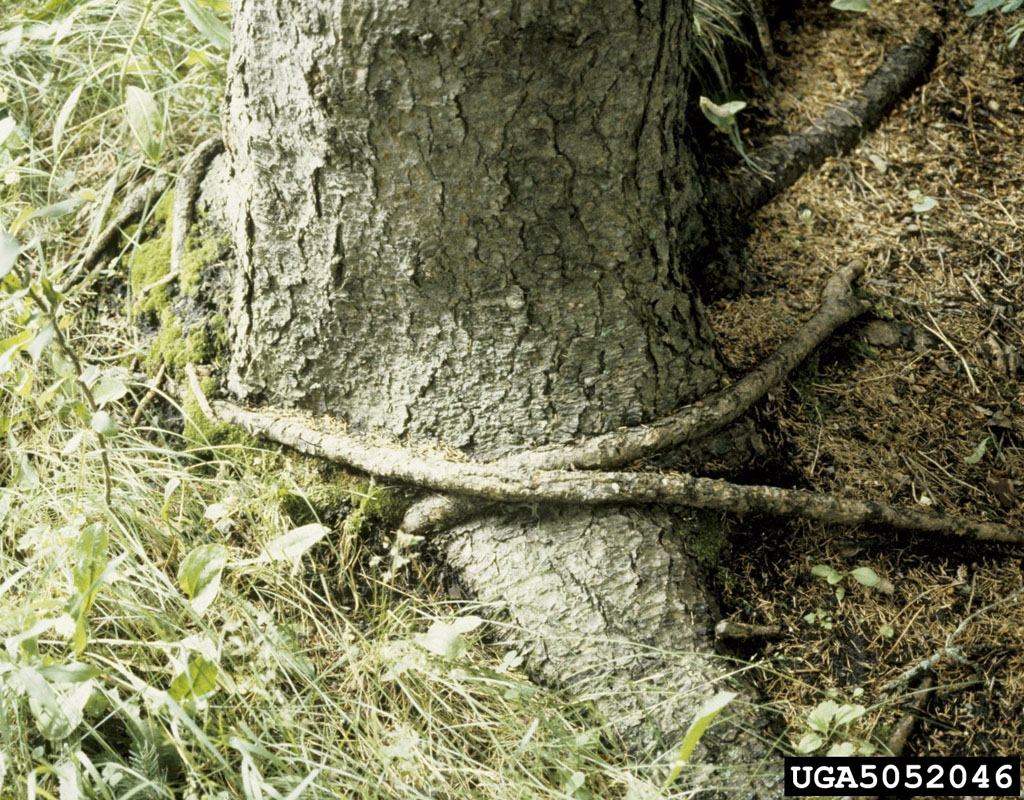
Image courtesy of Joseph OBrien, USDA Forest Service, Bugwood.org
Can I prevent or correct circling roots?
Sometimes, there’s nothing to be done for a girdled tree, and removing the tree is the only viable option. Depending on its age and size, a tree’s roots may have grown too large and rigid, forming a tangle of roots that can’t be undone.
But, often, a girdled tree can be helped.
How to Correct Root Girdling in Potted Trees
For a young tree grown in a pot or container, the first thing to do is remove it from its pot and expose the rootball. Ideally, this should be done during dormancy, when a tree is not growing and there’s no risk of water stress.
Wash the soil from the rootball and examine it to evaluate how many roots you can prune off and which should stay. First, trim or move aside fibrous roots. Any flexible roots should be gently coaxed into better positions where they can grow laterally. For rigid roots that can’t be moved or repositioned, prune them back to a point before they begin to encircle. This is the best way to encourage new growth that won’t kink or grow circularly.
Then, position the remaining roots over the soil in a much larger container or over the base of soil in a planting hole. Make a mound at the bottom of the planting hole and compact the soil with your foot so the newly planted tree won’t sink as the soil settles. Position the roots over this mound and backfill the planting hole. This is usually a two-person job, as the tree needs to be held in position while the hole is backfilled.
NOTE: This is the same process you’ll use for newly planted trees that are showing signs of girdling, usually within a year or two of transplanting.
Dealing With Girdling Roots in Established Trees
For trees that are already well established, the process is more complicated and should be done by professionals. First, the soil around the tree’s root ball must be excavated so that the roots can be examined. This is done by hand or with an air spade. Although air spades may look ferocious, they are the safest method for exposing roots, as well as for remedying compacted soil.
The roots of established trees are more complex, so an experienced tree care professional should be the one to evaluate the condition of the girdled roots and the likelihood of root pruning success. If root pruning can help, the rootball will be carefully pruned.
Larger circling roots present unique challenges, as removing them may stress a tree to the point where recovery is impossible. Girdled roots may also be the primary source of nutrient uptake, leading to a debate over cutting them at all.
And sometimes the only solution to a girdled tree is to remove it and plant a new one.
What should I do if I think my tree has girdled roots?
If you have a struggling, stunted, or leaning tree, get it evaluated by a tree care professional. An evaluation will narrow down the possible reasons for your tree’s loss of vigor, and a professional will give you realistic options about what to do. No professional will encourage you to leave a problem tree in place if it threatens life or property. Instead, they will explain the likely outcomes of treating a girdled tree and when removal is the best option.
American Climbers Can Help With Girdled Roots
Girdling roots are dangerous to your tree but also challenging to identify. By the time the problem becomes apparent, it may be too late to save your tree.
At American Climbers, we’ve dealt with many cases of girdling roots in the MetroWest area of Massachusetts. Our team is ready to evaluate the problem and give you an honest opinion on whether a tree can be saved or if removal is the best way to protect you and your family.
While it can be devastating to have to remove a tree, leaving a declining, girdled tree in place can be worse. Call us today at 508-497-8628 or request a quote online to schedule a tree inspection.
Blog Topics
Recent Posts
What's Happening? Stay Informed!
Stay on top of local events, pest and disease updates, tree and landscape tips, and more. Delivered straight to your inbox each month.

